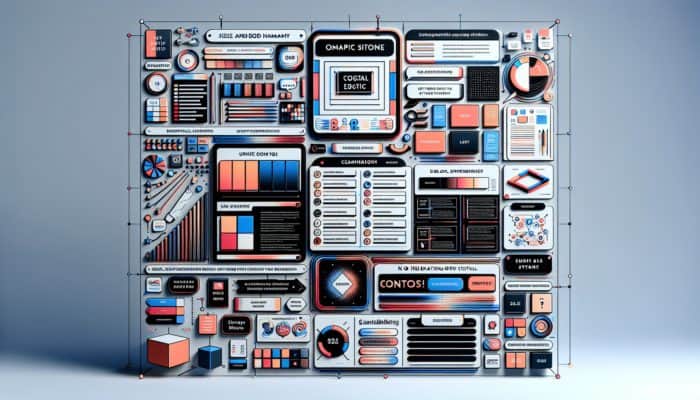Unlocking the Full Potential of Structured Content to Enhance User Experience
Understanding the Critical Importance of Structured Content in Effective Communication

Structured content is essential in elevating readability and comprehension, enabling users to swiftly locate and assimilate information. The logical arrangement of content not only transforms the reading experience but also enhances navigation and promotes better retention of key details. The multifaceted benefits of structured content include:
- Improved readability through a clear and systematic organisation of information, which simplifies user navigation.
- Enhanced comprehension as content is presented in a sequential manner that supports understanding.
- Boosted user engagement since users can navigate through the material with ease.
- Reduced bounce rates by offering quick access to relevant information.
- Increased accessibility for users with varying needs and preferences, ensuring inclusivity.
- Easier content updates that streamline the maintenance of information.
- SEO-optimised content, which leads to improved visibility and outreach.
Ready to Discover Insights for Enhanced User Engagement?
In today’s information-saturated environment, the advantages of structured content are indispensable. By implementing structured content practices, content creators can ensure that their messages resonate effectively with their target audiences, ultimately leading to enhanced satisfaction and increased engagement.
Key Elements for Effectively Structuring Your Content
The core components necessary for successfully structuring content include headings, bullet points, and concise paragraphs. Headings act as navigational guides that direct readers through the text, highlighting key topics of interest and importance. Bullet points simplify complex information into easily digestible snippets, allowing users to skim for relevant details quickly. Concise paragraphs help to alleviate visual fatigue and promote faster reading by presenting information in manageable, succinct units. The structure of content extends beyond mere aesthetics; it fundamentally impacts how readers engage with and process information, thereby significantly enhancing their overall experience and satisfaction.
The Impact of Content Structure on User Engagement Levels
A well-organised content layout can dramatically boost user engagement by making information more accessible and less daunting. Research has shown that users are more likely to stay on a page that features clearly defined information and systematic organisation. For instance, studies indicate that websites with defined headings and bullet points can enhance user interaction by nearly 50%. Furthermore, engaging users through well-structured content is correlated with longer session durations and reduced bounce rates. By prioritising structured content, creators can foster an environment that encourages exploration, leading to heightened engagement and overall satisfaction.
Proven Strategies for Establishing a Robust Content Structure

To effectively implement structured content, it is crucial to adhere to several best practices. First and foremost, using clear and descriptive headings that reflect the essence of the content is vital; this approach guides the reader’s journey through the material. Secondly, ensuring consistent formatting throughout the content fosters familiarity and reduces cognitive load on the reader. Additionally, a logical progression of ideas is paramount; concepts should flow intuitively and naturally. Lastly, incorporating visual elements like images or infographics can boost comprehension and complement the written text. By adhering to these guidelines, content creators can significantly elevate the user experience of their materials.
Technological Tools for Streamlining Content Structuring
Utilising the right tools and technologies can greatly simplify the process of structuring content. Content management systems (CMS) such as WordPress and Drupal provide user-friendly interfaces for modifying content layout and structure, while authoring tools like Canva assist in creating visually appealing graphics that complement structured text. Furthermore, SEO plugins and extensions can ensure that structured content is optimised for search engines, significantly enhancing overall visibility. By leveraging these technologies, creators can improve both the organisation of their content and its overall impact on user engagement and accessibility.
Techniques to Enhance Content Scannability for an Optimal User Experience
Utilising Visual Hierarchy to Improve Scannability

The principle of visual hierarchy significantly enhances content scannability by utilising size, colour, and placement to guide the reader's focus. By prioritising information through strategic visual cues, creators can effectively direct users to the most pertinent details. Techniques for establishing a strong visual hierarchy include:
- Employing larger fonts for headings to make them easily distinguishable from body text.
- Implementing contrasting colours to emphasise key pieces of information.
- Organising content logically, ensuring that the most critical information is presented first.
- Incorporating images or icons that complement the text and draw attention to significant points.
Collectively, these techniques enhance the user experience by simplifying navigation through the content. A well-executed visual hierarchy not only captures attention but also facilitates a quicker understanding of essential messages.
The Vital Role of White Space in Improving Content Structure
Often underestimated, white space is crucial in enhancing content scannability. Effectively utilising white space allows for the segmentation of content, reducing visual clutter and providing the reader's eye a chance to rest. This psychological effect creates a more inviting reading environment. When users encounter content with ample white space, they are less likely to feel overwhelmed and are more inclined to engage actively with the material. Strategically placing white space around text, images, and lists can significantly increase comprehension and retention, thereby enriching the overall user experience.
Perfecting the Use of Headings and Subheadings
Strategically employing headings and subheadings is essential for dividing content into manageable sections. This segmentation empowers users to swiftly navigate to the information they need. For example, a well-organised blog post may feature main headings for overarching themes, with subheadings dedicated to specific topics within those themes. Effective heading structures should be both clear and concise, reflecting the content's intent while remaining informative and engaging. By achieving this clarity, readers can easily scan through headings and subheadings, pinpointing areas of interest without needing to sift through dense blocks of text.
Insights from Experts on Structured Content for Enhanced User Experience
What Are the Recommendations from Industry Experts Regarding Structured Content?
Experts in the field agree that structured content is essential for boosting user engagement and retention. Numerous successful brands have made structured content a core component of their digital strategies. For instance, an e-commerce platform might utilise robust filtering options alongside structured product descriptions, simplifying the user's process of locating items that meet their specific requirements. This strategy has been associated with increased conversion rates and improved customer satisfaction. By understanding and applying expert recommendations, businesses can create content that resonates deeply with their audience, driving both engagement and loyalty.
Best Practices Endorsed by Industry Leaders for Effective Content Structuring
Industry leaders consistently recommend the use of clear and concise language, coupled with uniform formatting, to enhance readability and scannability. Actionable steps involve adopting a standardised style guide to maintain consistency in tone and presentation. Additionally, utilising templates for various content types can streamline the creation process while ensuring coherence across platforms. Regularly reviewing user feedback and analytics is vital for refining structured content strategies, ensuring alignment with evolving user expectations. By implementing these best practices, organisations can significantly enhance the scannability and effectiveness of their content.
Enhancing Structured Content for SEO Success
Structured content is crucial for SEO optimisation as it streamlines the indexing and ranking processes for search engines. By employing schema markup, content creators can supply search engines with explicit information about their pages, enhancing visibility in search results. Moreover, using well-defined headings and bullet points can positively influence click-through rates, as users are more likely to engage with content that is easily digestible. Expert analysis indicates that optimising structured content benefits not only search engines but also significantly enhances the overall user experience, creating a mutually beneficial scenario for all stakeholders involved.
Success Stories Showcasing the Impact of Structured Content
Real-world case studies illustrate the substantial impact of structured content on user experience and engagement levels. For example, a global travel website revamped its content structure by incorporating clear headings, subheadings, and visual elements to enhance user experience. This restructuring resulted in an impressive 35% increase in user retention rates and a 40% boost in engagement metrics, underscoring the value of organised information. Similarly, a leading educational platform adopted structured course materials, leading to enhanced user satisfaction and a marked reduction in dropout rates. These examples demonstrate that investing in structured content yields tangible benefits across various industries.
Exploring the Influence of Content Structure on User Experience
The Primary Advantages of Structured Content for Enhancing User Experience
Structured content provides numerous advantages for improving user experience, making information more accessible and comprehensible. Key benefits include:
- Improved readability, enabling users to grasp concepts quickly and effortlessly.
- Enhanced navigation that ensures users can easily locate the information they require.
- Increased engagement and interaction with content due to a logical flow of ideas and organisation.
- Better retention of information, contributing to long-term comprehension and understanding.
Together, these benefits create a more satisfying user experience, fostering a positive relationship between content creators and their audience. By prioritising structured content, organisations can significantly elevate user satisfaction, ultimately resulting in increased loyalty and advocacy among users.
Investigating How Content Structure Influences User Retention Rates
The arrangement of content profoundly impacts how long users remain on a page and their likelihood of returning. Studies have demonstrated a strong correlation between well-structured content and increased user retention rates. When users encounter organised information that is easy to navigate, they are more likely to explore additional pages or content. In contrast, poorly structured content can lead to frustration, causing high bounce rates and reduced user loyalty. By recognising this relationship, content creators can focus on effective structuring to cultivate a dedicated audience that engages consistently and returns for further content.
Designing Content to Accommodate Diverse User Needs
Diverse users have varying requirements, necessitating tailored content structures to cater to different audiences. For instance, a blog aimed at industry professionals may feature comprehensive analyses and specialised terminology, while content targeted at general readers should use simpler language and more accessible formats. Employing personas during the content creation process can help identify the specific needs of different user segments, allowing for the design of structured content that resonates with each demographic. By meeting the distinct needs of their users, content creators can enhance engagement and satisfaction across their audience.
Assessing the Effectiveness of Structured Content
Essential Metrics for Evaluating Content Structure Performance
To effectively assess the impact of structured content, key metrics such as time on page, bounce rate, and user feedback are critical. The time users spend on a page reflects the engagement level of the content; longer durations typically suggest higher interest from users. In contrast, a high bounce rate may indicate that users are not finding relevant information quickly. User feedback, whether collected through surveys or comments, offers qualitative insights into what works well and what requires improvement. By examining these metrics, creators can refine their content strategies, optimising for enhanced user experience and satisfaction.
Enhancing Content Structure Through A/B Testing
A/B testing different content structures can reveal which formats and designs yield the most favourable results for user engagement and retention. Effective A/B testing strategies involve:
- Testing variations of headings to assess user interest and engagement levels.
- Comparing different paragraph lengths to determine optimal readability.
- Experimenting with the positioning of images and bullet points for maximum impact.
- Evaluating the influence of different colour schemes on user engagement and retention.
By systematically testing these elements, content creators can gain actionable insights that inform future content structuring, thereby enhancing overall effectiveness and user satisfaction.
Recommended Tools for Analysing Content Scannability and Structure
A wide array of tools is available to evaluate the scannability and user-friendliness of content, aiding in the optimisation process. Notable tools include:
- Google Analytics for tracking user behaviour and engagement metrics, providing actionable insights.
- Crazy Egg for heat mapping and visualising user interactions across your content.
- Readable for assessing readability scores and offering structuring suggestions to improve user experience.
- ContentSquare for in-depth analytics on user engagement and interaction patterns, helping refine content strategies.
These tools provide invaluable insights into content performance, empowering creators to make informed adjustments that enhance scannability and overall user experience.
Real-World Case Studies Demonstrating the Success of Structured Content
Exploring real-world examples highlights how structured content has significantly improved user engagement and conversion rates. A notable case involved a healthcare provider that redesigned its website to incorporate clearly defined sections and user-friendly navigation. This transformation resulted in a remarkable 50% increase in appointment bookings. Another example is a financial services platform that implemented structured FAQs to address user queries more effectively, achieving a 30% reduction in customer support inquiries. These success stories emphasise the tangible benefits that structured content can deliver across various sectors, underscoring its importance in modern content strategies.
Research-Backed Benefits of Structured Content for Scannability and User Experience
Insights from Research on the Impact of Structured Content
Research consistently indicates that structured content can dramatically enhance user comprehension and engagement levels. Studies reveal that users are 60% more likely to engage with content that is effectively organised, leading to greater retention and satisfaction. Additionally, structured content has been shown to improve learning outcomes, especially in educational contexts where clear organisation facilitates information processing. By grounding content in research-backed principles, creators can ensure that their offerings effectively meet user needs while fostering engagement and retention.
How Structured Content Influences Reading Speed and Comprehension
Structured content positively influences reading speed by making information processing easier. When content is logically organised, readers can quickly identify key points without sifting through dense paragraphs. Research suggests that users can read structured content up to 30% faster than unstructured alternatives. This cognitive advantage not only enhances user satisfaction but also allows readers to absorb information more efficiently. Such improvements in reading speed are particularly crucial in our fast-paced digital environment, where attention spans are increasingly limited and users seek quick, digestible information.
Long-Term Benefits of Investing in Structured Content for User Loyalty
Over time, structured content can lead to increased user satisfaction and loyalty, ultimately fostering a positive brand perception. Users who consistently encounter well-organised content are more likely to return, as they associate the brand with quality and reliability. This long-lasting influence on user behaviour can result in higher conversion rates and advocacy, as satisfied users recommend the content to others. As the digital landscape continues to evolve, prioritising structured content will be essential for maintaining user loyalty and enhancing brand reputation.
Anticipating Future Trends in Content Structuring
Emerging Technologies Shaping the Future of Content Structuring
Emerging technologies are revolutionising how structured content is created and optimised. Artificial Intelligence (AI) and machine learning are becoming powerful tools that enable creators to automatically analyse user behaviour and preferences. These technologies can help generate personalised content recommendations, greatly enhancing the user experience. Additionally, they can streamline processes related to content organisation, ensuring that information is presented in the most effective manner. As these technologies continue to develop, their integration into content structuring will be increasingly crucial for enhancing user engagement and satisfaction.
Anticipating Changes in User Expectations Over Time
As user expectations evolve, content structure must adapt to meet the growing demands for speed and efficiency. Users are increasingly favouring content that is quick to digest and relevant to their immediate needs. Predictions suggest that content will need to become more concise, with a greater focus on visual elements that enhance readability and scannability. This evolution will require creators to continuously refine their strategies, ensuring alignment with the ever-changing landscape of user preferences and behaviours.
Adapting to New Patterns of Content Consumption for Enhanced Engagement
Content consumption patterns are shifting significantly, necessitating innovative approaches to content structuring. With the rise of mobile devices, users expect content to be easily accessible and optimised for smaller screens. This adaptation may involve implementing collapsible sections or using rapidly digestible formats, such as lists and bullet points, that cater to quick consumption. Additionally, as video content continues to gain prominence, integrating multimodal elements will be crucial for creating a cohesive experience that meets the diverse needs of users, ensuring they remain engaged and informed.
The Essential Role of Data Analytics in Refining Content Structuring
Data analytics play a critical role in optimising content structuring by providing insights into user engagement. By analysing user behaviour data, content creators can identify which sections resonate most with their audiences, allowing for targeted adjustments in content organisation. Moreover, leveraging analytics to monitor performance metrics enables continuous optimisation of content strategies, ensuring alignment with user preferences and behaviours. As data-driven decision-making becomes more prevalent, utilising analytics to guide content structuring will be paramount for achieving sustained success in a competitive digital landscape.
Integrating Multimodal Content into Structured Formats for Enhanced User Engagement
The rise of multimodal content necessitates new structuring techniques that seamlessly blend text, images, and videos for a coherent content experience. By thoughtfully combining these elements, creators can enhance engagement and cater to various learning styles. For instance, incorporating infographics alongside text can provide visual learners with an alternative means to absorb information. Similarly, embedding videos within structured content can create dynamic interactions that maintain user engagement. This integration is vital for addressing the diverse needs of a global audience, ensuring that all users find value in the content presented.
Frequently Asked Questions About Structured Content
What Is Structured Content?
Structured content refers to the systematic organisation of information designed to enhance readability and comprehension, often employing headings, bullet points, and short paragraphs to facilitate user navigation and understanding.
Why Is Scannability Important for Content?
Scannability is crucial as it enables users to quickly locate relevant information, thereby enhancing their overall experience and increasing engagement with the content.
What Steps Can Be Taken to Improve Content Structure?
Enhancing content structure involves utilising clear headings, maintaining consistent formatting, ensuring a logical flow of ideas, and incorporating visual elements that aid both comprehension and engagement while catering to user preferences.
What Tools Are Available for Effective Content Structuring?
Tools such as Google Analytics, Crazy Egg, and Readable can assist in analysing content performance and providing insights for structuring improvements, thereby enhancing user experience.
How Does Structured Content Contribute to SEO Success?
Structured content enhances SEO by simplifying the indexing process for search engines, improving visibility and click-through rates through the clear organisation of information that meets user needs and expectations.
Can You Provide Examples of Effective Structured Content?
Examples include well-organised blog posts, FAQs featuring clear headings, and e-commerce sites with categorised products and concise descriptions that enhance user navigation and satisfaction.
What Metrics Can Be Utilised to Measure the Effectiveness of Structured Content?
Effectiveness can be assessed through metrics such as time on page, bounce rate, user feedback, and levels of engagement, offering insights into user interaction with the content and its overall performance.
What Role Does White Space Play in Effective Content Structure?
White space reduces visual clutter, enhances readability, and provides the reader’s eye with a chance to rest, ultimately improving overall content scannability and comprehension for a better user experience.
How Can A/B Testing Improve Content Structure?
A/B testing allows content creators to experiment with various formats, enabling them to identify which structures yield the best results in terms of user engagement and retention, thereby refining content strategies.
What Future Trends Should Be Considered in Content Structuring?
Future trends encompass the integration of AI technologies, adapting to mobile consumption patterns, and the creation of multimodal content that addresses diverse user needs, ensuring relevance and engagement.
Connect with us on Facebook for More Insights!
The post Structure Content for Scannability and User Experience appeared first on Ezi Gold.
The Article Structure Content for Enhanced Scannability and UX Was Found On https://limitsofstrategy.com
The Article Structure Content for Better Scannability and User Experience found first on https://electroquench.com


